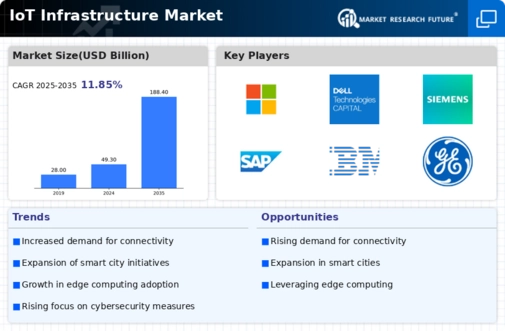Rising Demand for Smart Devices
The proliferation of smart devices is a primary driver of the IoT Infrastructure Market. As consumers increasingly adopt smart home technologies, wearables, and connected appliances, the demand for robust IoT infrastructure intensifies. According to recent estimates, the number of connected devices is projected to reach over 75 billion by 2025, necessitating advanced infrastructure to support seamless connectivity and data management. This surge in device adoption compels businesses to invest in scalable and secure IoT solutions, thereby propelling the growth of the IoT Infrastructure Market. Furthermore, the integration of these devices into everyday life enhances user experiences, creating a feedback loop that further drives demand for sophisticated infrastructure solutions.
Government Initiatives and Regulations
Government initiatives and regulations play a crucial role in shaping the IoT Infrastructure Market. Many governments are actively promoting the adoption of IoT technologies to enhance public services, improve infrastructure, and drive economic growth. For example, initiatives aimed at smart city development are encouraging investments in IoT infrastructure to support urban management and sustainability. Additionally, regulatory frameworks are being established to ensure data security and privacy, which are essential for fostering trust in IoT solutions. These government-led efforts not only stimulate market growth but also create a conducive environment for innovation within the IoT Infrastructure Market.
Expansion of Industrial IoT Applications
The expansion of Industrial IoT (IIoT) applications is significantly influencing the IoT Infrastructure Market. Industries such as manufacturing, logistics, and energy are increasingly leveraging IoT technologies to optimize operations, enhance productivity, and reduce costs. For instance, the IIoT market is expected to grow at a compound annual growth rate (CAGR) of over 25% in the coming years. This growth is largely attributed to the need for real-time data analytics and automation, which require a robust IoT infrastructure to function effectively. As organizations seek to implement smart factories and connected supply chains, the demand for reliable and scalable IoT infrastructure solutions is likely to increase, thereby driving market growth.
Increased Focus on Data Analytics and AI
The increased focus on data analytics and artificial intelligence (AI) is significantly impacting the IoT Infrastructure Market. Organizations are recognizing the value of the vast amounts of data generated by IoT devices and are seeking to harness this information for strategic decision-making. The integration of AI with IoT infrastructure allows for advanced data processing, predictive analytics, and automation, which can lead to improved operational efficiency and enhanced customer experiences. As businesses strive to become more data-driven, the demand for sophisticated IoT infrastructure that supports these capabilities is likely to rise. This trend not only drives innovation within the IoT Infrastructure Market but also encourages investment in new technologies and solutions.
Advancements in Connectivity Technologies
Advancements in connectivity technologies are a key driver of the IoT Infrastructure Market. The rollout of 5G networks is expected to revolutionize the way devices connect and communicate, offering higher speeds, lower latency, and greater capacity. This technological evolution enables more devices to connect simultaneously, facilitating the growth of IoT applications across various sectors. As 5G becomes more widely available, industries will likely invest in upgrading their IoT infrastructure to leverage these benefits. Furthermore, the integration of technologies such as LPWAN (Low Power Wide Area Network) and satellite communications is enhancing connectivity options, thereby expanding the potential applications of IoT solutions and driving market growth.


















Leave a Comment